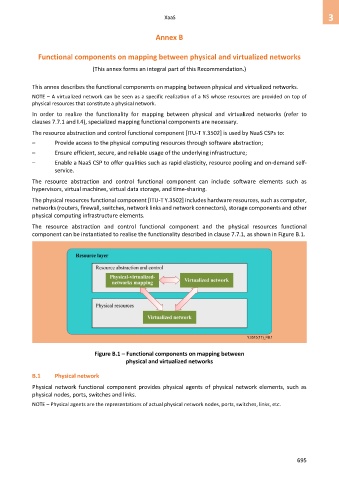Page 703 - Cloud computing: From paradigm to operation
P. 703
XaaS 3
Annex B
Functional components on mapping between physical and virtualized networks
(This annex forms an integral part of this Recommendation.)
This annex describes the functional components on mapping between physical and virtualized networks.
NOTE – A virtualized network can be seen as a specific realization of a NS whose resources are provided on top of
physical resources that constitute a physical network.
In order to realize the functionality for mapping between physical and virtualized networks (refer to
clauses 7.7.1 and I.4), specialized mapping functional components are necessary.
The resource abstraction and control functional component [ITU-T Y.3502] is used by NaaS CSPs to:
– Provide access to the physical computing resources through software abstraction;
– Ensure efficient, secure, and reliable usage of the underlying infrastructure;
– Enable a NaaS CSP to offer qualities such as rapid elasticity, resource pooling and on-demand self-
service.
The resource abstraction and control functional component can include software elements such as
hypervisors, virtual machines, virtual data storage, and time-sharing.
The physical resources functional component [ITU-T Y.3502] includes hardware resources, such as computer,
networks (routers, firewall, switches, network links and network connectors), storage components and other
physical computing infrastructure elements.
The resource abstraction and control functional component and the physical resources functional
component can be instantiated to realise the functionality described in clause 7.7.1, as shown in Figure B.1.
Figure B.1 – Functional components on mapping between
physical and virtualized networks
B.1 Physical network
Physical network functional component provides physical agents of physical network elements, such as
physical nodes, ports, switches and links.
NOTE – Physical agents are the representations of actual physical network nodes, ports, switches, links, etc.
695

